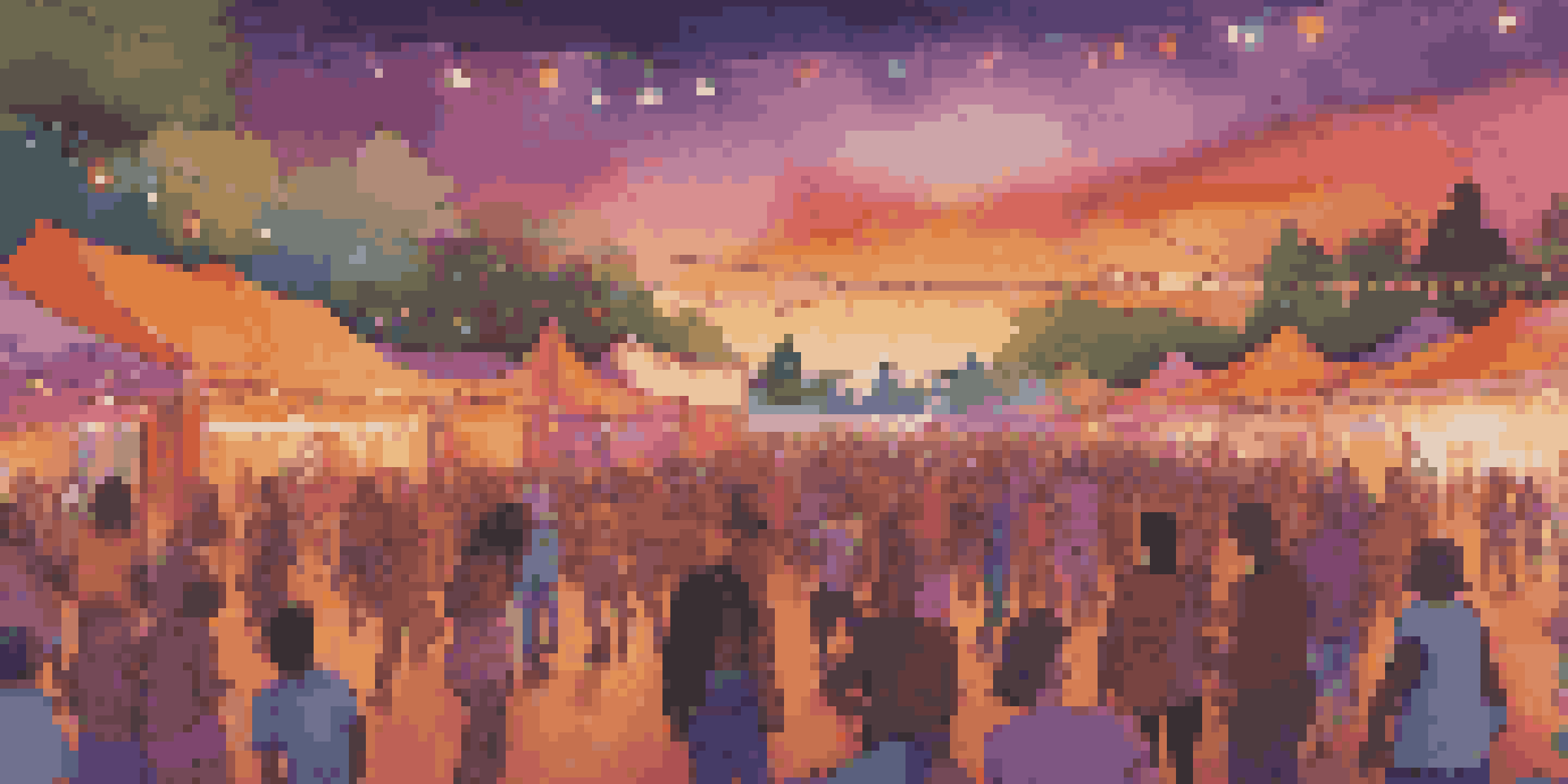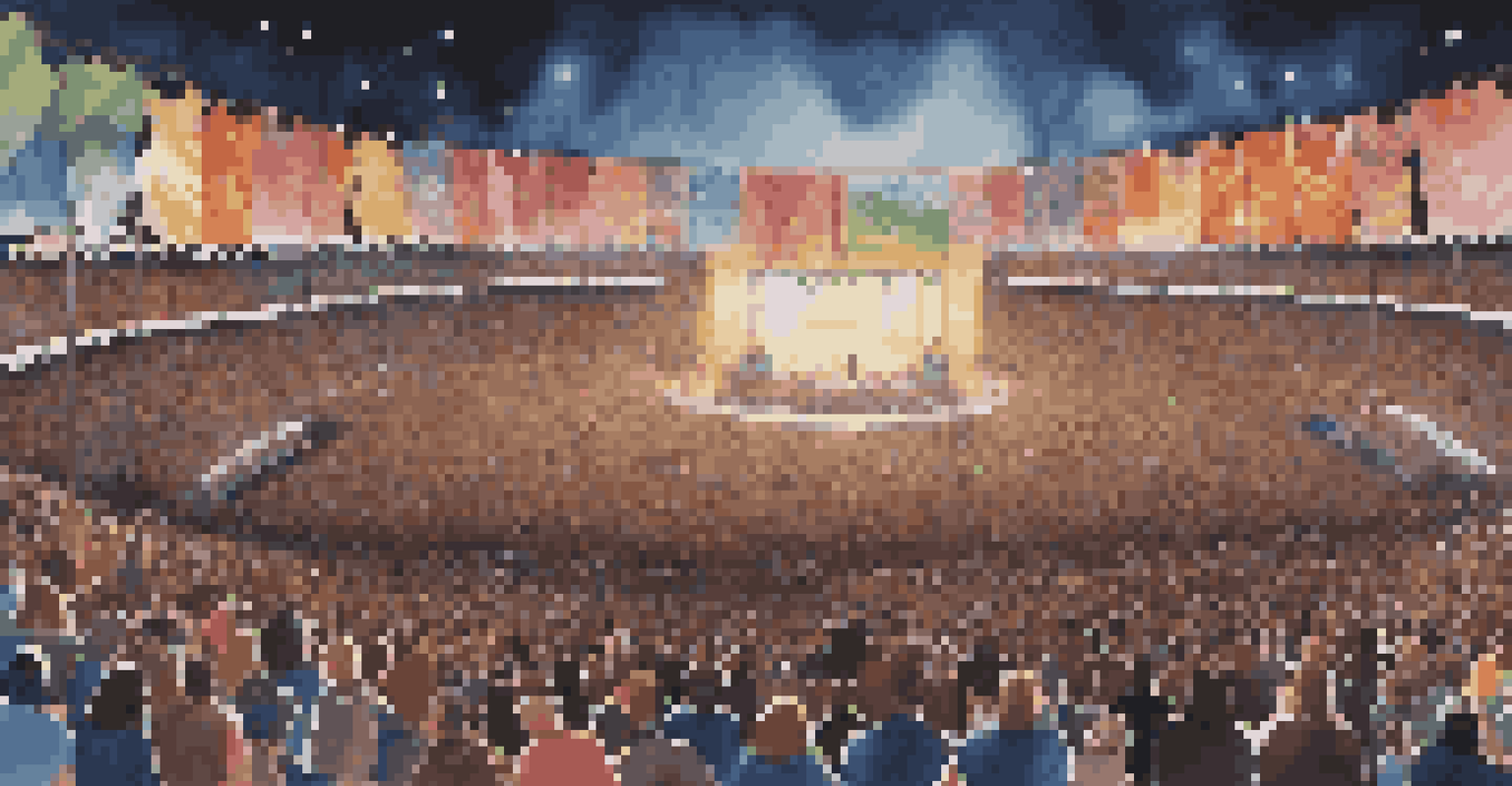An Examination of Music Festivals and Social Media Trends

The Rise of Music Festivals in the Digital Age
Music festivals have exploded in popularity over the past decade. With big names and vibrant atmospheres, these events attract fans from around the globe. Social media plays a crucial role in this growth, as it allows festivals to reach wider audiences instantly.
Social media is the ultimate equalizer. It gives a voice and a platform to anyone willing to engage.
Platforms like Instagram and TikTok give festivals a visual presence that draws in attendees. Artists and fans alike share their experiences, creating buzz that traditional marketing can't match. This digital buzz often leads to skyrocketing ticket sales, as people want to be part of the excitement.
Moreover, the interconnectedness of social media helps cultivate communities around these events. Fans can connect with each other both online and offline, deepening their festival experience and fostering a sense of belonging.
How Social Media Shapes Festival Experiences
Social media doesn't just promote festivals; it shapes how we experience them. From live streaming performances to sharing behind-the-scenes content, platforms enhance the festival atmosphere. Fans can engage in real-time, making them feel like part of the action, even from afar.

Additionally, festivals leverage user-generated content to build hype. Attendees often post photos and videos, and this organic promotion can create a viral effect, attracting even more visitors. It's a modern twist on word-of-mouth marketing that's incredibly effective.
The ability to share experiences instantly also encourages attendees to be more creative. People curate their festival looks and moments for social media, turning these events into visual showcases. This not only enhances personal experiences but also elevates the festival's overall brand.
Key Social Media Strategies for Festivals
Successful festivals employ various social media strategies to engage fans. For starters, they create unique hashtags that attendees can use, making it easy to follow the conversation. These hashtags become a part of the festival culture, connecting people before, during, and after the event.
The purpose of social media is to facilitate communication and build relationships.
Contests and giveaways are also popular strategies. Festivals might encourage fans to share their stories or photos for a chance to win VIP passes or exclusive merchandise. This not only boosts engagement but also generates a sense of excitement and anticipation leading up to the event.
Lastly, real-time updates during the festival keep fans informed and engaged. Whether it's announcing set times, weather updates, or surprise performers, social media serves as a vital communication tool that enhances the overall experience.
The Role of Influencers in Music Festivals
Influencers play a significant role in the marketing of music festivals. Their established follower base allows festivals to reach potential attendees who might not have been aware of the event. By partnering with influencers, festivals can tap into niche markets and attract diverse audiences.
When influencers attend festivals, their posts often showcase the experience in a relatable way. This authentic representation resonates with their followers, making them more likely to consider attending in the future. It's not just about selling tickets; it's about fostering genuine interest and excitement.
Moreover, influencers can provide valuable insights into festival experiences. Their content often includes tips and recommendations, helping potential attendees navigate the event. This kind of guidance can be crucial for first-timers, making them feel more prepared and excited about the experience.
The Impact of Live Streaming on Festivals
Live streaming has transformed how people engage with music festivals. With platforms like Facebook Live and YouTube, fans who can't attend in person can still experience the magic from home. This accessibility broadens the festival's reach and allows artists to connect with a global audience.
Moreover, live streaming can create a buzz that enhances the on-site experience. Those watching online often share their excitement across social media, which can lead to increased interest in future events. This digital presence can turn casual viewers into dedicated fans.
However, the implications of live streaming are complex. While it democratizes access to music festivals, it also raises questions about exclusivity and the need for physical attendance. Balancing live streaming with the unique in-person experience is essential for festivals to maintain their charm.
Festival Trends Influenced by Social Media
Social media trends have a significant influence on festival programming and themes. For example, the rise of sustainability has led many festivals to adopt eco-friendly practices, a topic that resonates well on social media. Attendees are increasingly drawn to festivals that align with their values.
Additionally, the popularity of certain music genres can often be traced back to what's trending online. Festivals are adapting their lineups to include more diverse artists, reflecting the changing tastes of audiences. This responsiveness helps festivals stay relevant and appealing.
Furthermore, unique experiences are now a key selling point. Festivals are incorporating interactive elements and installations that encourage attendees to share their experiences online. This not only enhances the festival's appeal but also boosts its visibility on social media.
Challenges and Opportunities in the Social Media Landscape
While social media offers numerous benefits for music festivals, it also presents challenges. Negative feedback can spread rapidly, and a single bad experience can tarnish a festival's reputation. This highlights the importance of effective social media management and customer engagement.
Additionally, the ever-changing nature of social media platforms means festivals must stay agile. What works one year might not be effective the next. Festivals need to continuously adapt their strategies to meet the expectations of audiences who are used to constant innovation.

However, these challenges also present opportunities. Festivals can learn from audience feedback and improve their offerings in real-time. By listening to their attendees, festivals can create more meaningful experiences that resonate well, ensuring continued success in the vibrant festival landscape.